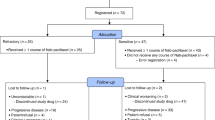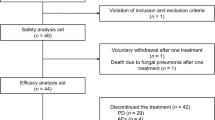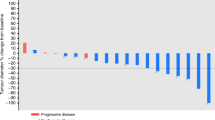Abstract
In a multicentre trial of the EORTC-Early Clinical Trials Group (ECTG) we treated 31 chemotherapy-naive patients with advanced non-small-cell lung cancer (NSCLC) with rhizoxin, a novel tubulin-binding agent. The drug was given as an i.v. bolus injection at 2 mg m-2 once every 3 weeks in an outpatient setting. Prophylactic antiemetics were not routinely given. Of the 29 eligible patients, nine had been treated surgically and three had received radiotherapy. The main toxic effects observed were stomatitis (34% of cycles) and neutropenia (41% of cycles). Neutropenic fever was rare (3% of cycles). Twenty-seven patients were evaluable for response. There were four partial responses (15%), while 13 patients (48%) showed stabilisation of their disease. The median duration of response was 7 months (range 6.0-10.7 months) and median survival from the start of rhizoxin treatment was 6 months (range 2-14.7 months). Rhizoxin as single agent shows activity in patients with advanced NSCLC.
This is a preview of subscription content, access via your institution
Access options
Subscribe to this journal
Receive 24 print issues and online access
$259.00 per year
only $10.79 per issue
Buy this article
- Purchase on Springer Link
- Instant access to full article PDF
Prices may be subject to local taxes which are calculated during checkout
Similar content being viewed by others
Author information
Authors and Affiliations
Rights and permissions
About this article
Cite this article
Kaplan, S., Hanauske, A., Pavlidis, N. et al. Single agent activity of rhizoxin in non-small-cell lung cancer: a phase II trial of the EORTC Early Clinical Trials Group. Br J Cancer 73, 403–405 (1996). https://doi.org/10.1038/bjc.1996.70
Issue Date:
DOI: https://doi.org/10.1038/bjc.1996.70



